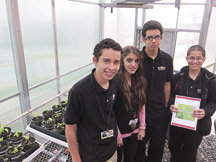Mahmod Elkyal, a North Bergen High School ninth grader, said the lab hours that his environmental science class has spent in the school’s greenhouse have taught him about the need for – and uses of – plants.
“I learned how we measure plants, how it can be useful in life,” said Elkyal, “that plants are needed to survive and we can also use them for cooking. Without plants, there wouldn’t be oxygen. [They] also eat away at carbon dioxide and it also helps affect global warming.”
According to North Bergen High School Science Department Chair Al Orlando, this year the state required that their ninth grade environmental science course include a lab component. They decided to incorporate the school’s greenhouse and grow basil there.
“Without plants there wouldn’t be oxygen.” – Mahmod Elkyal
________
“I thought it was going to be really exciting, and it really is,” said Jose Martinez. “I thought the fertilized [plant] would be growing quicker, but the non-fertilized plant was actually faster. I guess it was just the soil.”
A growing interest
Reem Kanan said that while she always had an interest in science, before the class, she never knew much about how or why plants function.
Eagleson said that before the class, his students had never been exposed to a greenhouse before. He said that every chapter in their textbook could be expanded upon by holding classes in the greenhouse. He said he planned to either grow pansies or marigolds now, and another plant in the spring.
“The kids got attached to the plants,” said Eagleson. “Some of the classes named their plants and they really took an interest in how they were growing. I thought it was really neat, and to be honest with you, three quarters of every class…didn’t even know what basil was, so I think it exposed them not only to science and doing graphs and charts, but real life. Something they could use when they grow up to cook.”
A few weeks ago, the students harvested their plants, but left about half the plant behind so that it could continue to grow.
Cooking from scratch
While wheeling their plants from the greenhouse to the classroom to measure them, Eagleson said that the students encountered Hannah Cohen, the school’s HealthCorps coordinator. HealthCorps is a program in which a school teacher is placed in the school for two years to instruct the students on healthy living.
She suggested that after harvesting the plant, they could make pesto with it and cook with the finished product. So after dutifully completing their scientific study, they had a pasta party.
Eagleson said that many of the students had never tasted pesto before.
Elkyal said that it was good, while Martinez said it helped him learn about eating healthy.
“In part, it says something to be able to take a plant that you grew and cook with it, because when you go to the grocery store, everything is already picked, sometimes washed, and bagged for you and you don’t have a connection to where does my food come from, why is basil nutritious,” said Cohen. “When you cook with it, after having grown and cared for the plant, it establishes that connection. It really makes you appreciate your food more.”
Tricia Tirella may be reached at TriciaT@hudsonreporter.com.
